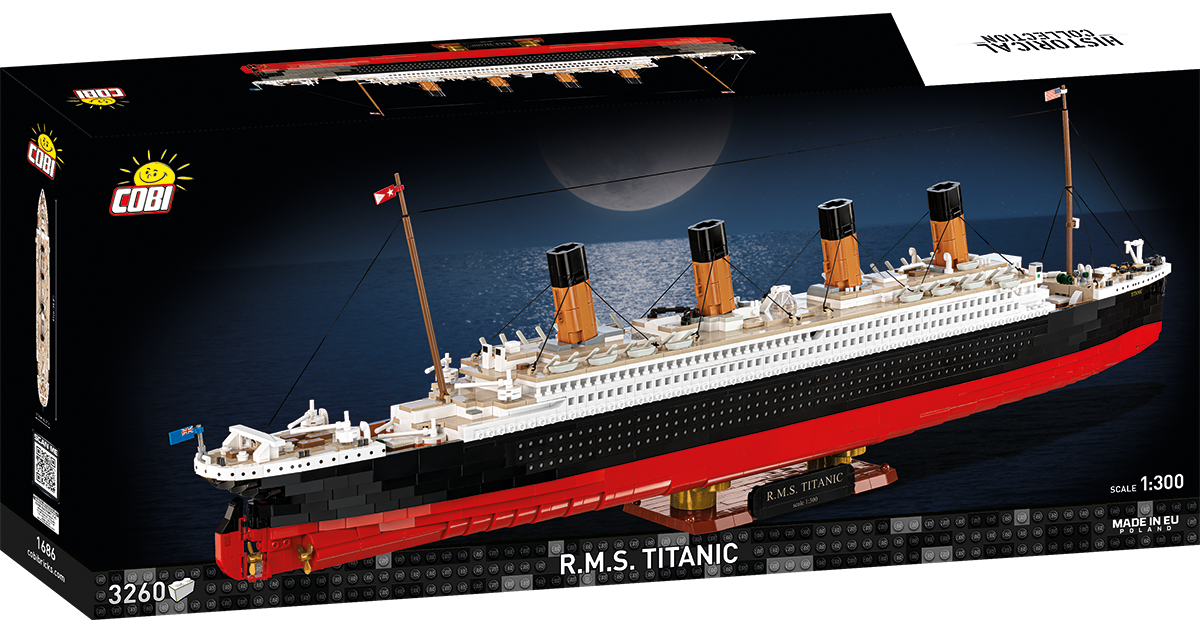The Art of Display Storytelling: How Collectors Use COBI Builds to Share History
Stories shape how people connect, and displays can speak just as clearly as words. Collectors use COBI building sets to go beyond simple models, turning them into narratives filled with history, memory, and emotion. A shelf of bricks becomes a stage where meaning unfolds in creative ways.
What makes these displays compelling is the sets and the choices that bring them to life. Lighting, spacing, and placement intentionally guide the eye, drawing viewers deeper into the story. Even quiet moments, like a space or a shadow, can carry as much weight as the centerpiece itself.
Every decision adds another layer of meaning. Some displays highlight dramatic moments, while others lean into subtler details that leave room for reflection. Together, they show how COBI building sets can express ideas in ways that feel both personal and universal.
Below, you’ll find approaches collectors use to turn their displays into stories that resonate far beyond the builds themselves.
Designing for Narrative Flow
Collectors arrange displays with intention so the eye moves with purpose. Each element connects to the next, creating rhythm and momentum. This design strategy transforms objects into a story that unfolds piece by piece.
Here is how structured display design works in practice:
Hierarchy of Focus - A strong focal point draws the eye to a clear starting place. Supporting elements are scaled and arranged to step down in importance, giving the viewer a guided path.
Transitions Through Contrast - Shifts in scale, color, or texture act as bridges between objects. These contrasts prevent stagnation while keeping movement smooth and connected.
Thematic Clusters - Grouping items by subject or concept creates natural chapters within the display. Each cluster provides context while advancing the larger story.
Directional Lines - Angles, frames, or implied sightlines lead the viewer’s gaze forward. These cues ensure the experience unfolds in a logical and engaging order.
A well-structured display turns looking into reading, guiding the viewer through a story without words.
Using COBI Building Sets as Historical Anchors
COBI building sets make history feel real and concrete. A single model, such as a ship or tank, can stand as the centerpiece of a display. That one object fixes the story in a clear moment and gives viewers a direct link to the past.
Additional items around the main set expand the story. Photos, maps, or smaller models add details that highlight the importance of the central piece. Each supporting element builds a stronger sense of context and meaning.
A display built on one COBI set works as a steady anchor. Viewers find a clear starting point that guides them through the story. Careful placement turns a group of objects into a structured historical scene.
Balancing Tension and Resolution
Strong displays use contrast to keep attention. Chaotic arrangements filled with color and motion create energy that feels unpredictable. Calm and orderly sections give relief and offer the eye a place to pause. This rise and fall mirrors the rhythm of a story.
Collectors shape this rhythm with intent. Placing busy pieces next to simple ones creates balance that feels natural. Each shift resets the mood and builds anticipation for what follows. Viewers experience a sense of movement instead of a static presentation.
Spacing also shapes how tension and release are felt. Crowded areas create pressure while open gaps provide a release. Each transition sets the stage for the next part of the display. This structure keeps the viewer engaged from start to finish.
A display that balances tension with resolution feels dynamic. Viewers sense the rise and fall as they move through the arrangement. Smart design choices turn individual objects into a story that flows with clarity and energy.
Lighting COBI Building Sets for Symbolism
Lighting changes how viewers read a display. A bright spotlight on a model can suggest victory or strength. Shadows and dim light can shift the mood toward loss or aftermath, giving the set deeper meaning.
Collectors use these contrasts to guide interpretation. A tank under strong light feels like a symbol of triumph, while a damaged vehicle in low light suggests the cost of war. Each lighting choice shapes the story without adding a single word.
Well-planned lighting turns models into symbolic characters. Through brightness and shadow, viewers connect emotion to the scene. This approach transforms static sets into living parts of a narrative.
Guiding the Viewer with Color
Color directs attention and sets the mood in any display. Warm tones suggest memory, reflection, and human emotion. Cooler hues point toward order, precision, and technical detail.
Collectors use this contrast to shape how viewers read the story. A section filled with warm reds or yellows can feel personal and emotional. Cooler blues and grays then shift focus to accuracy, scale, or detail.
Balanced use of color keeps the display clear and layered. Emotional parts stand apart from technical ones without confusion. Each shade helps the viewer move through the story with purpose.
Using COBI Building Sets as Story Chapters
COBI sets work as more than a single object; they can break a story into parts. Each set acts like a chapter that moves the narrative forward and gives structure to the display.
Establishing Context
Opening chapters set the stage for what follows. A set placed at the start introduces time, place, and background. This context helps viewers understand the conditions before the main events begin.
Marking Turning Points
Some sets highlight critical changes in direction. A battle scene or a key vehicle signals a moment where outcomes shift. These turning points keep the story from feeling flat and show why events matter.
Showing Consequences
Later chapters often deal with the aftermath. A model of damage or retreat communicates impact without needing words. This stage reminds viewers that actions carry lasting results.
Closing the Narrative
The final set acts as a resolution. Placement and tone suggest whether the story ends with triumph, loss, or reflection. A strong closing leaves viewers with a sense of completion.
Strategic Use of Empty Space
Empty space directs how viewers move through a display. Pauses between models slow the pace and prevent clutter. Each gap makes the eye focus on one section before moving forward.
Collectors often use these spaces to control rhythm. After a dramatic model, a wide gap allows the viewer to process its meaning. Shorter breaks keep momentum steady and guide attention smoothly.
Well-placed empty space gives each piece its own weight. Viewers sense when to stop and when to continue. This design choice turns silence into part of the story.
Symbolic Positioning
Position shapes how viewers read meaning in a display. A piece raised above others signals importance and control. A model placed low or hidden in shadow points toward struggle or loss.
Collectors use these height shifts to create layers of interpretation. Elevated figures can represent leaders or moments of triumph. Lowered or obscured pieces remind viewers of hardship and the weight of conflict.
Shifts in placement also control how stories unfold. A central position pulls attention first, while objects on the edge feel secondary. This arrangement guides the eye through a clear order of meaning.
Symbolic positioning turns arrangement into language. Every height, shadow, and placement choice communicates something beyond the model itself. Displays gain depth when objects speak through where they stand.
COBI Sets Paired with Personal Narratives
COBI sets often take on deeper meaning when tied to personal stories. A model connected to a family member’s service or a place of origin carries weight beyond its design. This link turns the build into a living reminder of history.
Collectors highlight these connections to make displays more intimate. A tank may stand for a grandfather’s role in a campaign. A ship might honor a family journey across the sea. Each choice adds personal depth that viewers feel right away.
Personal narratives also help others engage with the display. Visitors relate more when they hear the story behind the model. What begins as a set of bricks becomes a bridge between history and lived experience.
COBI Sets Framed by Backgrounds
Backgrounds transform COBI sets from isolated models into scenes with depth. A backdrop connects the build to a larger environment and strengthens its story. Viewers gain context that makes each piece feel part of a living moment.
Consider the ways backgrounds add weight to a display:
Historical Accuracy - A backdrop of maps, landscapes, or period architecture ties the model to its real setting. This detail roots the display in fact and makes the build more than a standalone piece.
Emotional Tone - Colors and textures behind the model shape the mood. A dark sky may signal conflict, while calm scenery can suggest peace or resolution.
Depth and Scale - Background layers create a sense of size beyond the model itself. A distant horizon or layered terrain helps the display feel larger and more immersive.
Narrative Continuity - Backdrops link multiple sets into a shared story. Connected environments guide the viewer through one continuous account.
Framing with backgrounds turns models into complete scenes. This gives every display both context and atmosphere.
Highlighting Turning Points
Displays gain strength when they center on a dramatic moment. A single clash, decision, or change draws attention and marks the high point of the story. Viewers sense where tension peaks and understand that what follows will look different.
Surrounding pieces provide context that shapes meaning. Objects placed before the climax set up conditions and expectations. Elements arranged after show consequences and resolution, making the display feel like a complete arc.
Turning points work because they give structure. Instead of scattered highlights, the story follows a clear rise, peak, and fall. Viewers walk away with a sense of progression and a memory of the moment that defined the display.
Creating Illusions of Motion
Static models often feel more alive when arranged with movement in mind. Angled placement suggests direction, while staggered heights create energy. Viewers sense action even though every piece is fixed in place.
Collectors use this technique to turn simple builds into dynamic scenes. A tank tilted forward looks like it is advancing, while figures angled toward one another suggest conflict. These details give the impression of motion without altering the models themselves.
Spacing also plays a role in creating flow. Tight clusters can signal urgency or impact, while wider gaps slow the pace and let the eye rest. Each choice affects how the viewer reads the scene as unfolding action.
Illusions of motion make displays feel immersive. Instead of standing outside the setup, viewers feel like they have stepped into a moment caught in time. This approach transforms static models into powerful visual stories.
Use COBI Sets as Conversation Starters
COBI sets invite people to talk because they link to shared history. A familiar tank, plane, or ship draws attention and sparks curiosity. Viewers often feel encouraged to share what they know or ask questions.
Displays gain value when they prompt discussion. Family members might recall personal stories, while younger viewers connect what they see to lessons in school. Each exchange turns the display into a shared learning moment.
Conversation builds a connection between the collector and the audience. Instead of a quiet viewing, the display becomes an active space where knowledge and memories flow. COBI sets work as bridges that bring history into everyday talk.
Spotlighting COBI Building Sets as Heroes
Strong lighting gives a model presence that nothing else in the display can match. A tank, plane, or ship under a direct beam stands out as the central figure. Viewers understand its importance right away.
Collectors often use this technique to frame a set as the hero of the story. Bright light creates a sense of honor or triumph, giving the piece symbolic weight. Other models then act as supporting elements around it.
Shadows add more depth to the effect. A glowing centerpiece surrounded by dimmer areas feels commanding, while contrast highlights its role as the focus. This balance makes the display easy to read.
Spotlighting turns a single COBI set into the heart of the narrative. The glow draws attention, and the surrounding context reinforces meaning. Every viewer leaves with a clear memory of the hero piece.
Staging Cause-and-Effect
Displays gain strength when they show action followed by a result. Viewers follow a clear chain of events that feels natural and easy to understand.
Showing Decisions
A display can focus on a choice made by a leader or group. The set showing the moment of decision becomes the cause. Positioning helps viewers see how this choice shaped what comes next.
Revealing Consequences
Outcomes often carry weight that surpasses the action itself. A damaged vehicle or ruined structure shows the cost of what happened. These pieces remind viewers that every action leaves a mark.
Building Contrast
Strong cause-and-effect stories often depend on visual differences. A calm scene on one side can shift into chaos on the other. This sudden change highlights how quickly circumstances can turn.
Creating Flow
Placement directs the eye from cause to effect without confusion. Angles, spacing, and scale guide the viewer step by step. The story becomes easy to follow because the path is built into the layout.
Framing Through Scale
Scale shapes how viewers read meaning in a display. Larger models naturally command attention and suggest strength or authority. Smaller pieces placed nearby emphasize fragility or dependence.
Collectors use this contrast to create hierarchy within the story. A large tank beside a small vehicle highlights dominance. A towering ship near smaller crafts shows control over the scene.
Size differences also guide movement through the display. The eye goes first to the largest form, then shifts to supporting details. This sequence creates a clear order that strengthens the narrative.
Bringing Stories to Life with COBI Building Sets
Every display is more than a collection of bricks. It becomes a chance to tell a meaningful and lasting story. COBI building sets give collectors the tools to share history, emotion, and imagination in a way that resonates with others, turning simple builds into stories worth remembering.
Key Takeaways
How do COBI building sets tell a story in a display?
When arranged with intention, COBI sets become more than models. Placement, lighting, and spacing guide the eye so viewers follow a clear narrative.
What makes COBI displays feel historically meaningful?
A single set can anchor the story in a specific moment, while maps, photos, and smaller pieces add context. This combination connects the build to real events and personal history.
How can lighting and color change the meaning of a COBI display?
Spotlights, shadows, warm tones, and cool hues all shape mood and symbolism. These choices influence whether viewers see triumph, loss, memory, or precision.
Why do collectors use space and scale in COBI displays?
Empty areas slow the pace and give weight to each model, while size contrast creates hierarchy. Together, they control rhythm and show power or vulnerability.
How do COBI sets start conversations with viewers?
Recognizable subjects like tanks or ships spark curiosity and discussion. People share stories, ask questions, and connect personal experiences to the display.



